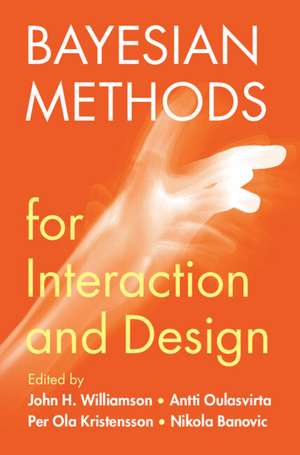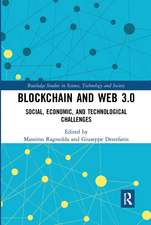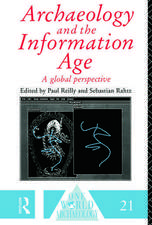Bayesian Methods for Interaction and Design
Editat de John H. Williamson, Antti Oulasvirta, Per Ola Kristensson, Nikola Banovicen Limba Engleză Hardback – 24 aug 2022
| Toate formatele și edițiile | Preț | Express |
|---|---|---|
| Paperback (1) | 264.20 lei 6-8 săpt. | |
| Cambridge University Press – 24 aug 2022 | 264.20 lei 6-8 săpt. | |
| Hardback (1) | 673.58 lei 6-8 săpt. | |
| Cambridge University Press – 24 aug 2022 | 673.58 lei 6-8 săpt. |
Preț: 673.58 lei
Preț vechi: 841.96 lei
-20% Nou
Puncte Express: 1010
Preț estimativ în valută:
128.93€ • 140.09$ • 108.37£
128.93€ • 140.09$ • 108.37£
Carte tipărită la comandă
Livrare economică 21 aprilie-05 mai
Preluare comenzi: 021 569.72.76
Specificații
ISBN-13: 9781108834995
ISBN-10: 110883499X
Pagini: 400
Dimensiuni: 157 x 235 x 26 mm
Greutate: 0.67 kg
Ediția:Nouă
Editura: Cambridge University Press
Colecția Cambridge University Press
Locul publicării:New York, United States
ISBN-10: 110883499X
Pagini: 400
Dimensiuni: 157 x 235 x 26 mm
Greutate: 0.67 kg
Ediția:Nouă
Editura: Cambridge University Press
Colecția Cambridge University Press
Locul publicării:New York, United States
Cuprins
Preface Nikola Banovic, Per Ola Kristensson, Antti Oulasvirta and John H. Williamson; Part I. Introduction to Bayesian Methods: 1. An introduction to Bayesian methods for interaction design John H. Williamson; 2. Bayesian statistics Alan Dix; Part II. Probabilistic Interfaces and Inference of Intent: 3. Bayesian information gain to design interaction Wanyu Liu, Olivier Rioul and Michel Beaudouin-Lafon; 4. Bayesian command selection Suwen Zhu, Xiangmin Fan, Feng Tian and Xiaojun Bi; 5. Probabilistic UI representation and reasoning in touch interfaces Daniel Buschek; 6. Statistical keyboard decoding Dylan Gaines, John Dudley, Per Ola Kristensson and Keith Vertanen; 7. Human–Computer interaction design and inverse problems Roderick Murray-Smith, John H. Williamson and Francesco Tonolini; Part III. Bayesian Optimisation in Interaction Design: 8. Preferential Bayesian optimisation for visual design Yuki Koyama, Toby Chong and Takeo Igarashi; 9. Bayesian optimisation of interface features John Dudley and Per Ola Kristensson; Part IV. Bayesian Cognitive Modelling: 10. Cue integration in input performance Byungjoo Lee; 11. Bayesian parameter inference for cognitive simulators Jussi P.P. Jokinen, Ulpu Remes, Tuomo Kujala and Jukka Corander; Part V. Appendix. Mathematical background and notation John H. Williamson.
Descriere
Introduces Bayesian methods and their implementation in application ranging from pointing-based interfaces to modelling cognitive processes.
Recenzii
'More than half a century since network flow theory was introduced by the 1962 book of L.R. Ford and D.R. Fulkerson, the area is still active and attractive. This book, based on course materials taught at Stanford and Cornell Universities, offers a concise and succinct description of most of the important topics, as well as covering recent developments. Its use in graduate courses related to algorithms and optimization is highly recommended.' Toshihide Ibaraki, Kyoto College of Graduate Studies for Informatics
'A succinct and very readable account of network flow algorithms covering the classics and the latest developments. The perfect book for a course on network flow algorithms and a reference for the state of the art. It will be a frequently used addition to my bookshelf.' Kurt Mehlhorn, Max-Planck Institute for Informatics
'A succinct and very readable account of network flow algorithms covering the classics and the latest developments. The perfect book for a course on network flow algorithms and a reference for the state of the art. It will be a frequently used addition to my bookshelf.' Kurt Mehlhorn, Max-Planck Institute for Informatics




























